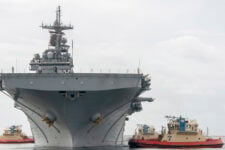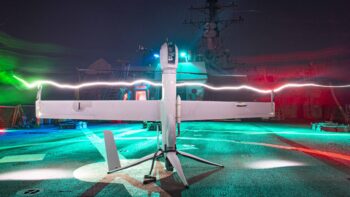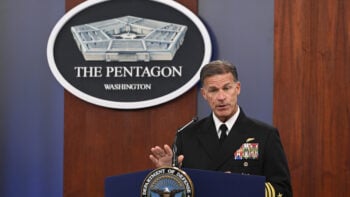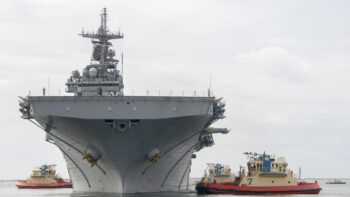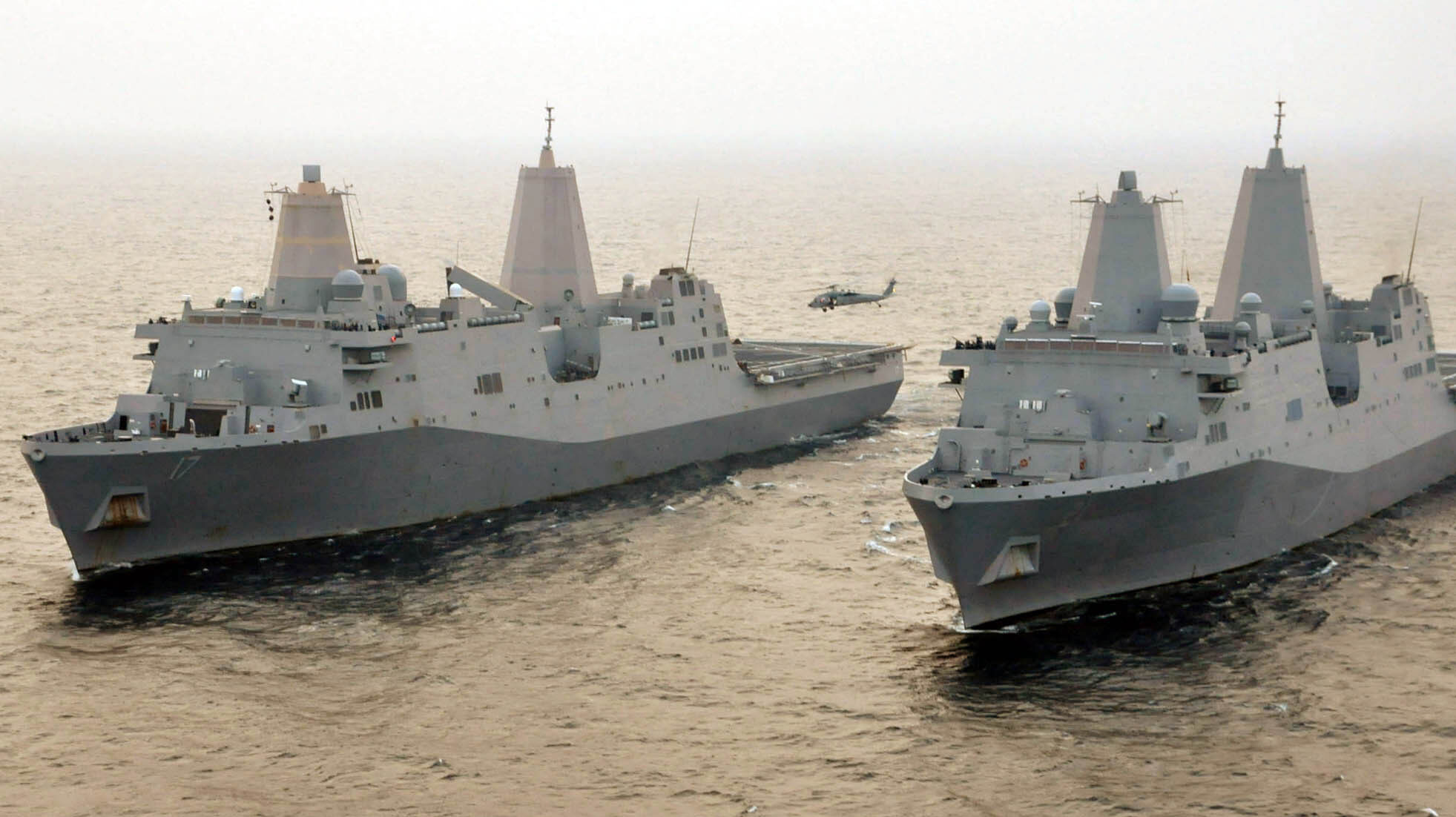
The amphibious transport dock ships USS San Antonio and USS New York underway together in the Atlantic Ocean off the coast of Virginia. (U.S. Navy photo by Petty Officer 1st Class Edwin F. Bryan)
WEST 2023 — Ahead of the Biden administration’s defense budget roll out next month, the Marine Corps’ second most senior officer is publicly making a new argument for the service’s amphibious shipbuilding request: The force needs them today because it can’t properly train for combat tomorrow without them.
“You don’t want the first time you go out the door to war … as a fight tonight force — that should not be the first time that young first lieutenant has landed a CH-53K or an Osprey on the deck of a pitching, rolling amphib,” Gen. Eric Smith, assistant commandant of the Marine Corps, said Tuesday during the West 2023 symposium here in San Diego.
“A young lance corporal moving their [Amphibious Combat Vehicle] into a wet well, pitching rolling deck, two- or three- footer [waves]. They shouldn’t be doing that at night on the way to a war. They should be doing it today over and over and over again until it’s just rote,” he continued.
RELATED: New tech to help ACV in surf zone, general ‘looks forward’ to scrutiny after rocky training cycles
Smith’s comments come weeks before the president’s new budget request is expected to be published in early March, and when the current Marine Corps commandant, Gen. David Berger, will likely have his last chance at fully convincing the Pentagon and lawmakers to embrace a key part of his Force Design 2030 initiative: Investing in the development and production of up to 35 Landing Ship Mediums, the vessel formerly called the “Light Amphibious Warship.”
Berger, Smith and other Marine Corps brass in recent years have argued as part of Force Design 2030 that the service will need 31 traditional amphibious ships, also called “L-class” vessels, and 35 LSMs to help shuttle Marines and their equipment around regions such as the island chains in the Indo-Pacific.
Smith, as well as the Marine Corps’ top requirements officer, Lt. Gen. Karsten Heckl, on Tuesday explained the Marine Corps envisions each Marine Littoral Regiment, a new unit also created under Force Design, would have nine LSMs available at any given time, leaving eight that could undergo maintenance.

Then-Lt. Gen. Eric Smith, commanding general of III Marine Expeditionary Force (MEF), listens to enlisted Marines during a meal at Marine Corps Air Station (MCAS) Iwakuni, Japan, Sept. 18, 2018. Smith visited MCAS Iwakuni for the first time as the III MEF commanding general. (U.S. Marine Corps photo by Cpl. Andrew Jones)
But amphibious shipbuilding, despite the hawkish efforts of some lawmakers, has always been an uphill battle in Congress. And their new name aside, the LSMs appear to be headed for the same roadblock that traditional L-class warships have been fighting for years. No matter how clearly service explains the need, there’s always a fierce fight for funding in the Navy’s crowded shipbuilding account.
For example, Breaking Defense previously reported that the Navy in its fiscal 2023 budget request sought to slash funding for the San Antonio-class amphibious transport docks in future budgets, potentially cutting even more amphibious ships Marine Corps leadership continues to publicly argue are desperately needed.
Lawmakers in the latest defense policy bill appear to have preempted that cut, but it is just one example of how the fight for Pentagon funding can happen both on Capitol Hill and internally within the military.
The long-awaited joint study between the Navy and Marine Corps on amphibious ships was delivered to lawmakers in January — several months late — however it’s results are classified, Defense One reported.
When asked by reporters about the Marine Corps’ priorities for the fiscal 2024 budget, Heckl, the service’s top requirements officer, reiterated that the LSM remains a top concern for the commandant.
FULL COVERAGE: Breaking Defense reports from West 2023
“The LSM is one of the commandant’s top priorities, so it’s going to get a lot of emphasis in the Marine Corps, but obviously… it’s going to be very largely dependent on the on the Navy,” he said.
Heckl added that he believes “a definitive way forward” will come into view “in the coming months” as the service wraps up the preliminary design review, an acquisition milestone signifying the Pentagon has an initial outline for what the new ship will look like and what it will need to serve its purpose. Heckl’s command, Marine Corps Combat Development Command, published a video about the service’s amphibious shipbuilding requirements on Tuesday.
During his speech Smith sought to tamp down on the narrative that amphibious ships were a “fight” between the Navy and the Marine Corps.
“The problem is not amphibs. The problem is funding Columbia,” he said, referring to the Columbia-class ballistic missile submarine, the Navy’s stated number one acquisition priority. “We’re not in disagreement about what we need. It’s a funding question.”






